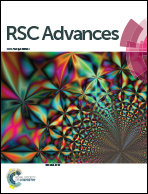Reasons behind the improved thermoelectric properties of poly(3-hexylthiophene) nanofiber networks†
Abstract
Enhanced thermoelectric properties of poly(3-hexylthiophene) nanofiber networks, doped in their reaction with silver cations, are presented. The role of charge carrier concentration and mobility (influenced by the supramolecular structure and nanoscale morphology) is discussed. The nanonet structure leads to a six fold increase in the ZT value compared to the bulk polymer counterpart.


 Please wait while we load your content...
Please wait while we load your content...